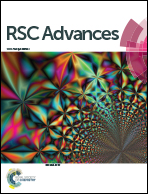The electrochemical performance of fluorinated ketjenblack as a cathode for lithium/fluorinated carbon batteries
Abstract
The inferior rate capacity of lithium/fluorinated carbon (Li/CFx) batteries limits their application in the field, requiring large discharge current and high power density. Herein, we report a novel type of fluorinated carbon with superior performance through gas-phase fluorination of ketjenblack. The investigation shows that the F/C ratio of the fluorinated ketjenblack (FKB) increases with the fluorination temperature, whereas the discharge voltage decreases due to the lowered content of semi-ionic C–F bonds. Accordingly, a suitable fluorination temperature of 520 °C was selected, under which the product exhibits the largest specific capacity of 924.6 mA h g−1 with discharge potential exceeding 3.1 V (vs. Li/Li+) and the highest energy density of 2544 W h kg−1 with power density of 27 493 W kg−1. This energy density is higher than the theoretical energy density of commercial fluorinated graphite (2180 W h kg−1). In addition, the sample delivers good rate capability demonstrated by a specific capacity retention ratio of 79.5% even at a current density of 20C. Therefore, the FKB material may have very promising practical applications in lithium primary batteries.



 Please wait while we load your content...
Please wait while we load your content...